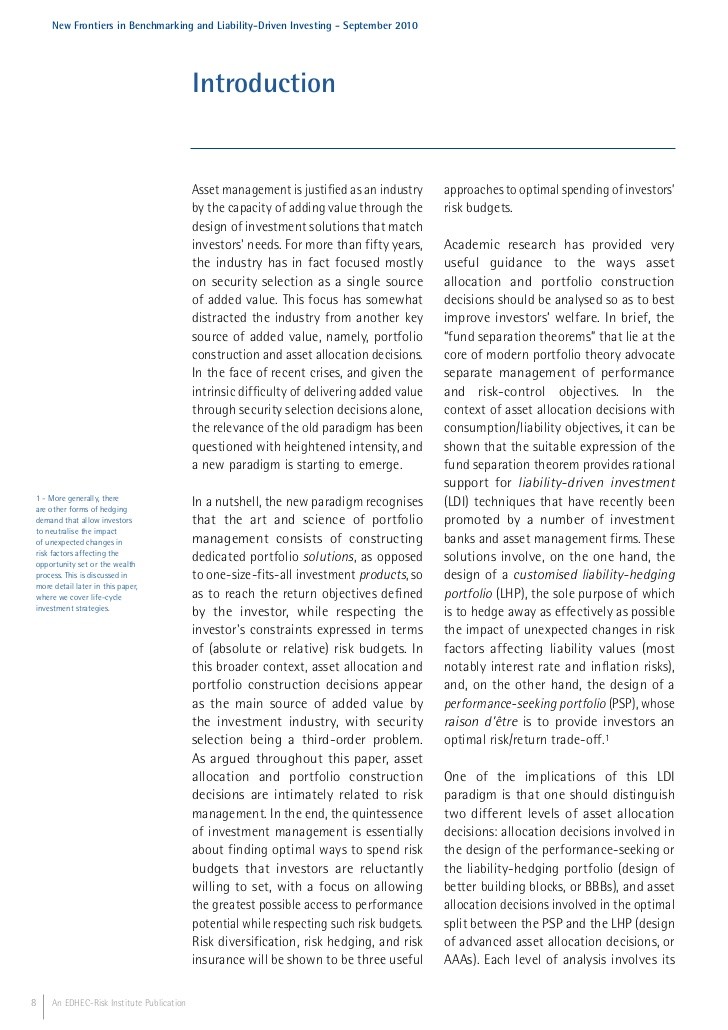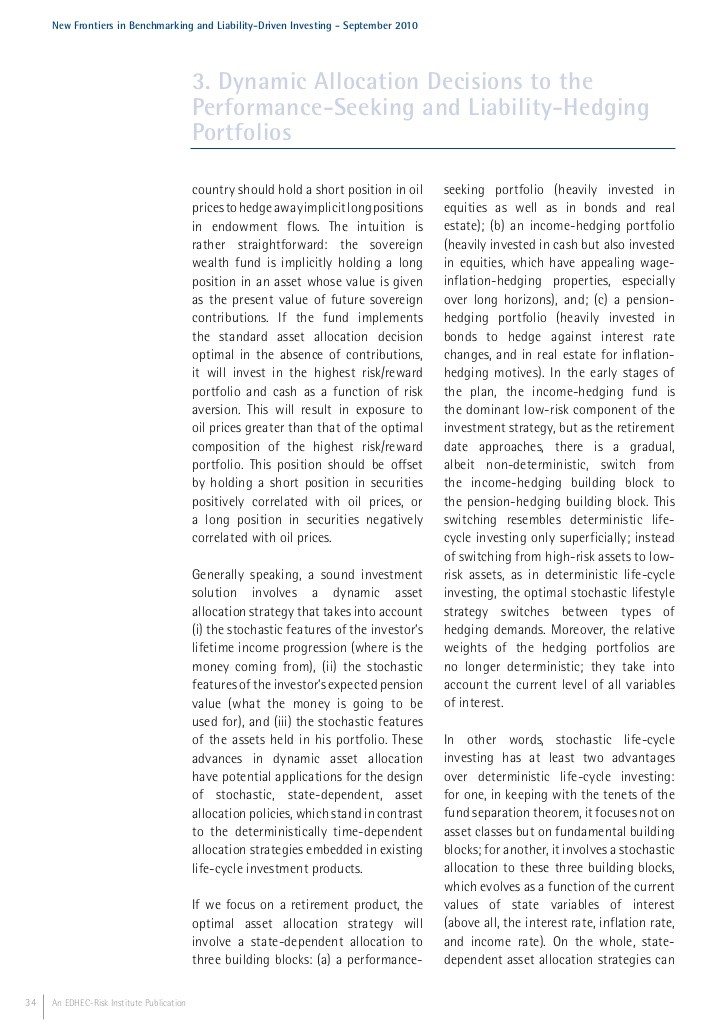EDHECRisk Yale School of Management – EDHECRisk Institute Strategic Asset Allocation and
Post on: 1 Июль, 2015 No Comment

Yale School of Management – EDHEC-Risk Institute Strategic Asset Allocation and Investment Solutions Seminar: Curriculum
A typical programme day lasts from 8:30 am to 5:30 pm and is usually divided into lectures and application cases.
Day 1: Roger G. Ibbotson
Morning Session: Fundamentals of Asset Allocation
It has been shown that asset allocation policy is a key factor in determining portfolio performance, even though the relative impact of the long-term asset allocation policy mix relative to the impact of active performance from timing, security selection or fees has often been grossly over-estimated in the literature. In this context, it is of critical importance for all investors to understand the fundamentals of sound asset allocation decisions. These fundamentals relate to some of the most profound questions in investment such as the exact nature of the risk-return relationship, the influence of risk factors on security returns, the empirical long-term analysis of risk premia across asset classes, as well as the relative importance of strategic versus tactical asset allocation decisions.
This morning session is designed to familiarize investors with strategic asset allocation for both institution and individual portfolios. We develop the risk and return relationships, valuation, diversification, multiple betas, optimization, and portfolio construction.
- Calculating present value and returns, valuation and discount rates, compounding and creating historical indexes of stocks, bonds, bills and inflation. Applying risk premiums to estimate discount rates and the cost of capital.
- Understanding diversification, alphas and betas. Estimating expected returns and explaining realized returns. Constructing portfolios and using optimization techniques to maximize return while minimizing risk.
- Explaining long term returns in stock and bond markets. Comparing the returns from asset allocation policy (strategic asset allocation or smart beta) with the returns from active management (timing and security selection, less fees). What portion of portfolio returns come from asset allocation policy? Why does your portfolio return differ from mine?
- Risk and Return across the asset classes. Risk and Return payoffs within the stock market. What works best? Can we achieve higher return and lower risk? Should we invest in the more or less popular stocks?
Afternoon Session: Measuring and Managing Diversification for Policy Portfolios
The first-order challenge for most investors is to design a strategic asset allocation benchmark, or policy portfolio, which will allow them to obtain the most diversified, and hence the best rewarded, access to risk premia across various asset classes. In principle, the prescription is straightforward: investors should generate meaningful estimates for risk and return parameters, and maximize risk-adjusted performance.
In practice, the situation is made complex by the lack of availability of reliable expected return estimates, so the focus shifts from the goal (max Sharpe ratio) to the mean (well-diversified portfolio). Recent research has highlighted that allocation decisions could be best expressed in terms of rewarded risk factors, as opposed to standard asset class decompositions. Looking through the asset class decomposition level to focus on the underlying factor decomposition level appears to be a perfectly legitimate approach; such ideas can be traced back to standard asset pricing models. The practical implications of this perspective in terms of the design of well-diversified asset allocation decisions are starting to emerge. While the benefits of diversification are intuitively clear, what exactly a well-diversified portfolio is remains a bit ambiguous.
This afternoon session will equip participants with an in-depth understanding of the challenges involved in implementing robust asset allocation decisions in the context of the design of a well-diversified portfolio of risky assets.
- From asset allocation to risk allocation: asset allocation decisions across asset classes versus portfolio construction decisions within asset classes; allocating to risk factors versus allocating to asset classes; from measurement of factor exposures to passive replication of, and optimal allocation to, factor exposures; consequences for institutional management of this change of paradigm.
- Measuring diversification: weight-based versus risk-based measures of diversification; measuring the number of independent bets in asset allocation decisions; turning correlated asset returns into uncorrelated factor returns; pros and cons of using principal component analysis versus minimum linear torsion.
- Managing diversification: from naive diversification to scientific diversification; assessing the out-of-sample performance of global minimum asset allocation variance benchmarks, maximum Sharpe ratio asset allocation benchmarks, equal risk contribution asset allocation benchmarks and diversified risk parity asset allocation benchmarks.

Day 2: Lionel Martellini
Morning Session: Incorporating Long-Term Liability Objectives
While diversification is a methodology well-suited to allow investors to efficiently extract risk premia out of performance-seeking assets, it is not the appropriate tool when it comes to protecting long-term liability needs, a challenge which is best addressed by hedging, which is another form of risk management.
Asset-liability management is characterized by a dual focus on performance generation through optimal exposure to rewarded risk factors so as to alleviate the burden on contributions versus hedging against unexpected shocks that impact current value of liabilities. The liability-driven investment (LDI) paradigm stipulates that risk and performance are two conflicting objectives that are best managed when managed separately. This approach calls for the design of two separate asset allocation benchmarks, a well-diversified performance-seeking portfolio (PSP) on the one hand, and a liability-hedging portfolio (LHP) that best tracks the liabilities on the other hand.
While the LDI paradigm suggests that investor welfare should depend on how good each building block is at delivering what it has been designed for, namely risk-adjusted performance benefits for the PSP, and hedging benefits for LHP, the interaction between performance and hedging motives is also expected to play an important role.
This morning session will introduce participants to a detailed analysis of the challenges involved in the design of LDI solutions, with a focus not only on matching the interest rate and inflation exposure on the asset and liability sides, but also on aligning the performance-seeking and liability-hedging portfolios for enhanced asset-liability management benefits.
- A brief history of ALM: cash flow matching, immunization, surplus optimization; fund separation theorem and LDI strategies; performance-seeking portfolio vs. liability-matching; portfolio; using derivatives to implement the liability-matching portfolio.
- Liability-hedging in the short-run and in the long-run: the trade-off between the short-term perspective, where interest rate risk dominates, and the long-term perspective, where inflation risk dominates; realized versus expected inflation risk; hedging inflation-linked liabilities without inflation-linked bonds; designing long/short nominal bond portfolio strategies to neutralize the exposure to unexpected changes in expected inflation.
- Beyond LDI: from fund separation theorems to fund interaction theorems; performance-seeking portfolios with attractive liability-hedging properties and liability-hedging portfolios with attractive performance properties; increasing the allocation to the performance-seeking portfolio without increases in risk budgets by enhancing its liability-hedging properties; trading-off diversification benefits versus hedging benefits.
Afternoon Session: Incorporating Short-Term Risk Constraints
Investors’ preferences include (regulatory or self-imposed) short-term risk constraints in addition to long-term objectives. This is a serious concern which requires the use of a new form of risk management given that managing such risk constraints with diversification is impractical (one can only diversify away specific risk, not systematic risk) and managing them with hedging is prohibitively costly.
While lower than those of deterministic strategies, downside risk levels can remain substantial for investment solutions designed to focus on achieving long-term objectives. Introducing a control over downside risk can be done through suitably-designed risk-controlled mechanisms that are specifically engineered so as to reduce the opportunity cost associated with downside protection.
Risk insurance is the form of risk management that is suited to allow investors to achieve long-term investment objectives while respecting short-term risk budgets and constraints.
This afternoon session will equip participants with an in-depth understanding of the various forms of insurance strategies, and how they can be implemented in an asset allocation context with or without the use of derivatives.
- From risk diversification to risk hedging: introducing risk management constraints into asset allocation; defining margin for error as a function of risk aversion; implementing time- and state-dependent asset allocation strategies for risk management; reviewing portfolio insurance strategies: constant proportion portfolio insurance vs. option-based portfolio insurance; understanding risk management techniques based on replication and on derivatives; introducing exotic structures.
- Using risk budgets as ingredients in the design of the optimal portfolio strategy; implementing martingale techniques in optimization; taking into account mean reversion in equity returns within the context of a riskcontrolled strategy; incorporating maximum drawdown constraints in product design; minimizing the costs of downside protection and maximizing access to the upside potential.
- Designing improved forms of long-term investment strategies for institutional or individual investors: capturing the benefits of mean-reversion in equity returns; including maximum drawdown constraints; introducing goal-oriented strategies; reducing the opportunity cost of downside risk hedging; using improved asset class benchmarks within long-term investment strategies.
Yale School of Management – EDHEC-Risk Institute Strategic Asset Allocation and Investment Solutions Seminar.














